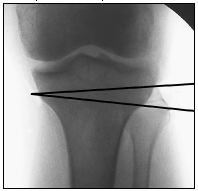
When is knee osteotomy indicated?
Osteotomy is effective for patients with arthritis in one compartment of the knee (see anatomy section). The medial compartment is on the inner side of the knee. The lateral compartment is on the outer side of the knee. Doctors are able to tell which compartment of the knee is affected based on symptoms, physical exam, x-rays, and/or the results of arthroscopic knee surgery. The affected compartment tends to collapse when arthritis is present. The goal of osteotomy is to correct that collapse and thereby reduce the weight on that compartment.
If the medial compartment is collapsed, a wedge of extra bone is inserted into medial aspect the shin bone (tibia). This changes the alignment of the knee. Less weight is placed on the arthritic medial compartment and more force is placed on the healthy lateral compartment. Some people will use an unloader brace prior to surgery to see if osteotomy has a role in improving their symptoms.
Osteotomy relieves pain associated with weight bearing activities. Best results are obtained when there is little pain at rest (i.e. pain only experienced during activity). Because there are no artificial parts left in the knee after surgery, activities that can not be performed after total knee replacement are still possible after osteotomy (e.g. jogging, impact sports, climbing). Osteotomy should therefore be considered before knee replacement for patients who are young, active, or heavy labourers.
Who is a good candidate for knee osteotomy?
Individuals who are not candidates for osteotomy include people who have arthritis in more than one knee compartment, knee instability, or severely restricted range of motion. As with any surgery, there is a small risk of infection. Other complications include fracture and malalignment of bones during healing. Orthopaedic surgeons that perform this type of surgery are able to discuss the risks of this procedure in more detail.
Read more about osteoarthritis of the knee. Links have been provided to other websites as well as online medical journals. Knee injury topics can also be accessed.
For more information on available treatment please read our “links” section.
